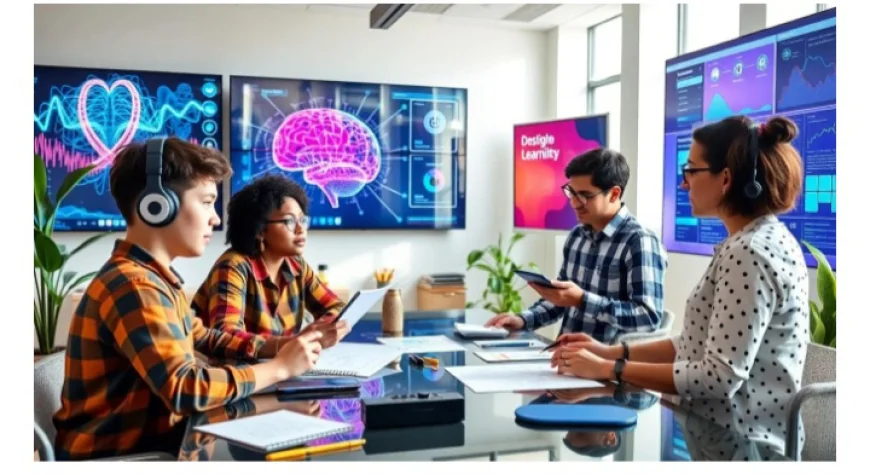Designing Learning Platforms with Neurodiversity in Mind
In today’s world, education is more inclusive than ever. Schools and online courses are starting to see the importance of embracing neurodiversity—different ways people think, learn, and process information. But many learning platforms still don’t meet the needs of neurodiverse learners. Too often, traditional designs overlook important cues for students with autism, ADHD, dyslexia, and other conditions. This gap causes learners to become frustrated or miss out on key lessons. When platforms aren’t built with neurodiversity in mind, students may struggle to stay engaged or retain knowledge. That’s a big loss for everyone. On the flip side, designing platforms that fit diverse mental profiles can boost engagement, improve understanding, and make education more accessible for all. It’s not just good help—it’s good learning.


Designing Learning Platforms with Neurodiversity in Mind
Introduction
In today’s world, education is more inclusive than ever. Schools and online courses are starting to see the importance of embracing neurodiversity—different ways people think, learn, and process information. But many learning platforms still don’t meet the needs of neurodiverse learners. Too often, traditional designs overlook important cues for students with autism, ADHD, dyslexia, and other conditions.
This gap causes learners to become frustrated or miss out on key lessons. When platforms aren’t built with neurodiversity in mind, students may struggle to stay engaged or retain knowledge. That’s a big loss for everyone. On the flip side, designing platforms that fit diverse mental profiles can boost engagement, improve understanding, and make education more accessible for all. It’s not just good help—it’s good learning.
Understanding Neurodiversity and Its Implications for Learning Platforms
What Is Neurodiversity?
Neurodiversity refers to the natural differences in brain wiring among people. It includes conditions like autism, ADHD, dyslexia, and dyspraxia. These conditions affect how people process data, focus, or communicate. They aren’t flaws, but ways the brain works differently.
Neurodiverse students make up a significant portion of classrooms—some estimates say 15-20%. Many face daily challenges like sensory overload, difficulties with timed tasks, or trouble following fast-paced instructions. These issues shouldn’t be ignored when designing learning systems.
Why Neurodiverse-Friendly Design Matters
Creating platforms that support neurodiversity is key to modern education. An inclusive design means better access and comfort for everyone. When platforms adapt to different needs, students tend to do better. They stay engaged longer, understand material more deeply, and feel more confident.
Experts like Dr. Thomas Armstrong champion these ideas. He points out that recognizing diverse brains helps unlock students’ hidden talents. By making learning tools flexible and responsive, we help all students shine.
Common Barriers Faced by Neurodiverse Learners in Traditional Platforms
Many platforms are built for a "one size fits all" approach. This often leads to problems such as:
- Sensory overload from bright visuals or loud sounds
- Inflexible layouts that can’t be customized
- Fast-moving content that’s hard to follow
- Strict timed assessments that cause anxiety
Recent studies show these barriers hurt the learning experience. They push neurodiverse students away from engaging fully with lessons.
Principles of Designing Neurodiversity-Inclusive Learning Platforms
Universal Design for Learning (UDL) Framework
The UDL framework is a foundation for building inclusive platforms. It encourages offering multiple ways to access information, stay engaged, and demonstrate learning. For instance, instead of just text, include images, videos, or interactive tasks.
By supporting different ways of learning, UDL helps students with varied needs succeed. It’s like having a toolkit that adapts to everyone instead of a single rigid system.
Flexibility and Customization
Anyone prefers their learning environment to suit their style. So, effective platforms allow users to adjust features like font size, color schemes, or page layout. Students can choose what helps them focus best.
Offering diverse assessment options is also important. Instead of only multiple-choice tests, include projects, oral presentations, or portfolios. This variety gives learners more ways to show what they know.
Sensory Considerations
An inclusive platform respects sensory sensitivities. It avoids bright flashing lights, loud sounds, or busy backgrounds. Instead, it offers sensory-friendly options, such as dimmer screens or mute buttons.
Allowing students to customize sensory settings creates a calmer, distraction-free environment. That encourages better focus and reduces overload.
Practical Strategies and Features for Neurodiversity-Friendly Platforms
Clear and Consistent Navigation
Simple, predictable menus help learners find their way easily. Use clear labels and logical steps. Visual cues like icons or color coding guide students without confusion.
Multimodal Content Delivery
Combine text, audio, videos, and interactive tools. Different learners process information differently—some prefer reading, others listening or doing. Multi-sensory content makes lessons more accessible and engaging.
Personalization and Adaptive Learning
Use technology to tailor content based on the learner's progress. Adaptive platforms can suggest easier or harder tasks depending on performance. Let students set their pace and choose preferences to boost confidence.
Inclusive Assessment Methods
Offer alternative ways to complete assignments. Instead of timed tests, students can do projects, record a presentation, or build a portfolio. This approach respects different processing speeds and reduces stress.
Supportive and Engaging Environment
Include social features like chat groups or peer mentoring. Incorporate emotional learning modules to promote self-awareness. A supportive community encourages learners to stay motivated and connected.
Implementation Challenges and Solutions
Technical and Design Constraints
Balancing advanced features with accessibility needs isn’t simple. Collaborate with neurodiverse individuals during design. Their insights help create more effective tools.
Cost and Resource Considerations
Adding inclusive features might seem costly, but there are affordable options. Leverage existing open-source tools or partner with organizations specializing in neurodiverse education. Success stories from schools show that smart planning makes it possible.
Evaluating Effectiveness
Regularly check if your platform works for neurodiverse learners. Collect feedback, track usage patterns, and measure learning gains. Use this data to improve features continually.
Real-World Examples of Neurodiversity-Inclusive Learning Platforms
- Microsoft’s Seeing AI and Learning Tools help visually impaired or dyslexic readers access information more easily.
- The Brain In Hand app offers personalized support for students with anxiety and executive functioning difficulties.
- Platforms like Knowbly and Kurzweil Education are designed to be fully inclusive, offering multiple ways to learn and demonstrate knowledge.
These examples show that inclusive design not only benefits neurodiverse students but enhances learning for everyone.
Conclusion
Creating learning platforms that support neurodiversity starts with understanding different cognitive needs. Applying principles like UDL and building in flexibility makes a real difference. It’s also crucial to keep working with neurodiverse learners and specialists to improve designs continually.
Designing with neurodiversity in mind isn’t a trend — it’s a necessity for a truly inclusive future. Developers and educators must prioritize accessibility to unlock the full potential of every learner. When we do, we’re not just making better tools—we’re shaping a more inclusive world of education that everyone can thrive in.



 VARSHITHA
VARSHITHA